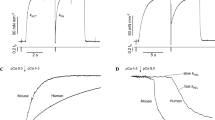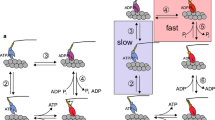Summary
Glycerol extracted fibre bundles or single fibres from the dorsolongitudinal muscle of Lethocerus maximus were suspended in ATP-saltsolution; they were then held isometrically or they were sinusoidally stretched and released about a mean length (102%L 0) at an oscillation amplitude of 1–4% of the length. At very low frequencies (less than 0,2 cycles/sec) the ATPase activity remained the same as under static conditions at the mean length since the activity increase produced by stretch was compensated by the activity reduction during release. At frequencies approaching 2–3 cycles/sec the ATPase activity greatly exceeded the activity level under static conditions (at the mean fibre length and even at the extended length) by an amount (Extra-ATPase activity) depending on the oscillation amplitude. At this frequency sinusoidal tension changes lagged behind sinusoidal length changes, indicating that the fibre preparation was producing oscillatory power (about 0.3 μ cal/min cm fibre). The power output was often proportional to the square of the oscillation amplitude and mostly proportional to the oscillation induced extra-ATPase activity, suggesting a close mechanochemical coupling in the sense of a biochemical ‘Fenn effect’. At an oscillation amplitude the of 3–4%L 0 maximal rates of extra ATP-splitting were observed, which amounted to 1–3 molecules of ATP split per crossbridge during each oscillation cycle. The mechanochemical coefficient approached 2–3 kcal/mole ATP split, indicating and ‘efficiency’ of up to 30%. We suggest that power producing oscillation increases the rate of actin-myosin interactions and we conclude that — like living muscle — the isolated contractile machinery transforms chemical energy (from ATP) into mechanical work with a high efficiency, and that the amount of work done controls the extent of the chemical reaction which takes place.
Similar content being viewed by others
References
Abbot, R. H., andH. G. Mannherz: In preparation.
Barany, M., andF. Jaisle: Biochim. biophys. Acta (Amst)41, 192 (1960).
Cain, D. F., A. A. Infante, andR. E. Davies: Nature (Lond.)196, 214 (1962).
Carlson, F. D., D. J. Hardy, andD. R. Wilkie: J. gen. Physiol.46, 851 (1963).
Chaplain, R. A., andR. T. Tregear: J. molec. Biol.21, 275 (1966).
Davies, R. E.: Nature (Lond.)199, 1068 (1963).
Fenn, W. O.: J. Physiol. (Lond.)58, 175 (1923).
Huxley, A. F.: Progr. Biophys. molec. Biol.7, 255 (1957).
Huxley, H. E., andJ. Hanson: In: The structure and function of muscle, vol. 1, p. 183, Ed.G. H. Bourne. New York: Academic Press 1960.
Jewell, B. R., andJ. C. Rüegg: Proc. roy. Soc. B164, 428 (1966).
Machin, K. E., andJ. W. S. Pringle: Proc. roy. Soc. B152, 311 (1960).
Mannherz, H. G.: Pflügers Arch.303, 230 (1968).
Maréchal, G.: Le métabolisme de la phosphorylcréatine et de l'adénosine triphosphate durant la contraction musculaire. Bruxelles: Arcia 1964.
Marsh, B. B.: Biochim. biophys. Acta (Amst.)32, 357 (1959).
Maruyama, K., andJ. W. S. Pringle: Arch. Biochem.120, 225 (1967).
Mommaerts, W. F. H. M., K. Seraydarian, andG. Maréchal: Biochim. biophys. Acta (Amst.)57, 1 (1962).
Podolsky, R. J.: In: The structure and function of muscle, vol 2, p. 359. Ed.G. H. Bourne: New York: Academic Press 1960.
Pringle, J. W. S.: Progr. Biophys. molec. Biol.17, 1 (1967).
Reedy, M. K.: Amer. Zool.7, 465 (1967).
——, andR. T. Tregear: Nature (Lond.)207, 1276 (1965
Rüegg, J. C.: Amer. Zool.7, 465 (1967).
——, andH. Stumpf: Pflügers Arch.305, 34 (1969).
——, andR. T. Tregear: Proc. roy. Soc. B165, 497 (1966).
Schädler, M.: Pflügers Arch. ges. Physiol.296, 70 (1967).
Steiger, G., andJ. C. Rüegg: Pflügers Arch. (in press).
Author information
Authors and Affiliations
Rights and permissions
About this article
Cite this article
Rüegg, J.C., Stumpf, H. The coupling of poweroutput and myofibrillar ATPase activity in glycerol-extracted insect fibrillar muscle at varying amplitude of ATP-driven oscillation. Pflugers Arch. 305, 21–33 (1968). https://doi.org/10.1007/BF00586393
Received:
Issue Date:
DOI: https://doi.org/10.1007/BF00586393
Key-Words
- Insect Flight muscle: Oscillation
- Oscillation Coupled ATPase
- Chemomechanical Energyconversion
- Contractile Mechanism: Efficiency




